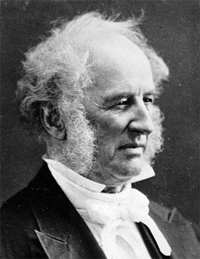Jeremiah G. Hamilton is an enigma, a mystery lost in time. He would break all the rules of the day. Even marrying a white woman, Eliza Jane Morris, said to be the daughter of the Honorable Robert Morris of Philadelphia, and was half his age. He was a Wall Street broker who was noted as the only black millionaire in New York City by James McCune Smith in the 19th century. Known as a shrewd financial agent, he amassed a fortune of approximately $200 million ($250 million in 2018) by the time of his death. Although he was the subject of a lot of newspaper coverage in his lifetime, he is virtually absent from the historical literature. Who was Jeremiah G. Hamilton? Where did he come from? Why is he such a mystery?
Everything about Hamilton is a mystery. Even the place and date of his birth, a story he would change often. According to the surviving census records, he stated he was born in Haiti or in Virginia in 1806 or 1807. He first came to prominence in 1828 after hiding out in a fishing boat in Port-au-Prince harbor while escaping Haitian authorities. After the Great Fire of New York in 1835, he accrued approximately $5 million by “taking pitiless advantage of several of the fire victims’ misfortunes” (White, 2013). His business practices were controversial even by today’s standards, earning him the nickname, “The Prince of Darkness.” He would buy a substantial amount of land and property in modern day Astoria and Poughkeepsie. Despite his wealth, he would be the victim of racism which was prevalent for the time. During the New York City Draft Riots, white men broke into his house, seeking to lynch him but his wife, Eliza Jane Hamilton, told them he was not at home. They would make off with liquor, cigars and an old suit (Bernstein, 1990). Hamilton wasn’t afraid to get personal or physical with his enemies. He left a “hefty footprint on the historical record” (White, 2013) as there are about tens of thousands of words written about him and 500 cases involving him either as a plaintiff or a defendant. There is a well documented physical altercation between Hamilton and a Justice Merrit after a courtroom encounter. The altercation occurred on the street as the judge would strike Hamilton with his cane. “Yet for all of their disdain, newspapermen and financiers conceded time and again that Jeremiah Hamilton was sharp as a razor and a formidable opponent” (White, 2013). He would even tangle with Cornelius “The Commodore” Vanderbilt, the richest and most famous man in New York City at the time. They would tangle over control of the Accessory Transit Company. After Vanderbilt’s death in 1877, one obituary article would mention his entanglements with Hamilton. Although Vanderbilt “did not fear him” because he feared no one, however “without a shadow of doubt” the Commodore respected him (White, 2013).According to biographer Shane White, no one will erect a statue honoring Jeremiah G. Hamilton as he was no saint. He was more aggressive, ruthless toward his competitors than most. As Wall Street is not for the faint of heart, Hamilton seemed to be made of stone as he conducted business, not caring who he stepped on to achieve his goals. Hamilton accumulated money, not caring about who he upset. Even when his clients suffered losses, he reaped profits. There is so much about the man that remains a mystery despite the historical record. There is no known picture of him. One that is often used is actually a Jeremiah J. Hamilton of Texas. Hamilton left behind very little personal information, no diaries, no letters or memories. He and his wife would have nine children. It seems his family seemed unconcerned or uninterested in preserving his memory. Hamilton was not viewed as a hero nor did he want to be (White, 2013). In conclusion, Jeremiah G. Hamilton died on May 19, 1875 at the age of 67/69 and provides a unique perspective on race in the 19th century. Despite his unique rise to wealth and power in New York City at a time when most black men and women still suffered under slavery, Hamilton is a mystery. I wonder if he wanted it that way. I wonder if he instructed his wife and children to destroy his remaining papers and ignore his place in history. It would not be unheard of but it is interesting that a man who had what most black men did not in his lifetime, would simply disappear. If it were not for the court and newspaper record, he would have completely disappeared from all knowledge.References
Bernstein, Iver (4 January 1990). The New York City Draft Riots: Their Significance for American Society and Politics in the Age of the Civil War. Oxford University Press. p. 35. Retrieved December 30, 2020.
White, Shane (July 25, 2013). Gotham’s Only Black Millionaire. New York Times, https://opinionator.blogs.nytimes.com/2013/07/25/gothams-only-black-millionaire/. Retrieved December 30, 2020.




really
ReplyDelete